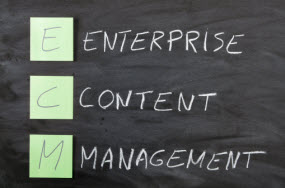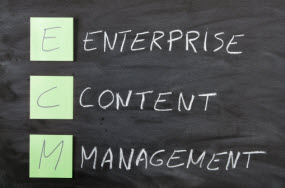 Let’s face it. ECM or Enterprise Content Management – the technologies focused on helping organizations control, manage, store, preserve, and deliver information tied to complex and mission-critical, document-intensive processes– has been around the block a few times. And the future of ECM has certainly been in the headlines the past week with the acquisition of Documentum by OpenText.
Let’s face it. ECM or Enterprise Content Management – the technologies focused on helping organizations control, manage, store, preserve, and deliver information tied to complex and mission-critical, document-intensive processes– has been around the block a few times. And the future of ECM has certainly been in the headlines the past week with the acquisition of Documentum by OpenText.
ECM’s long track record is something to build upon. Enterprise content management (ECM) technologies have delivered and continue to deliver tangible business value and are critical to automating back-end business processes. Content management is a cornerstone of many organizations, along with operations management, customer management and resource management. These organizations rely on ECM systems to get critical work done. Four out of five organizations with ECM systems would suffer “serious business disruption” if these systems were down for only one day.
Up until now, though, many of these benefits have been reserved for very large organizations. Our estimates are that over 70% of mid-sized organizations have yet to deploy ECM technologies. Why? Because legacy ECM systems are too difficult to deploy, too difficult to use, and too costly to integrate.
That’s all changing right now. Cloud and mobile technologies are revolutionizing what ECM is, what it can do, and increasing the number of organizations for whom ECM can deliver real and tangible value. ECM capabilities are now available to a host of new companies – at exactly the same moment that they are realizing that broken and paper-clogged business processes stand in the way of their journey to Digital Transformation.
So what does “legacy” ECM look like, and how is a “modern” ECM platform different? How does ECM need to change in order to assume the critical role it can and should play in driving Digital Transformation and enhanced customer experiences?
Here’s a recap of our view of how ECM is changing:
| Legacy ECM | Modern ECM |
| All about technology | All about applications |
| Mostly a large company thing | A business process improvement thing, at any size company |
| Usability and mobility an afterthought | Usability and mobility core |
| Cloud "someday" | Cloud now |
| IT buying technology | Business buying applications |
| Costly and complex integrations | Configurations replace customizations |
| Big bang, boil the ocean implementations that never get going |
Modest application-specific implementations that are leveraged and extended |
All of this means that a modern ECM platform has three core characteristics:
- It is flexible – both in how it is purchased and how it is deployed;
- It is scalable – modest initial roll outs and successes can easily be extended to other parts of the business; and
- It is fully featured – it can be relied upon to support both the process and the compliance requirements of the business.
Across the spectrum of enterprise technologies, ECM has an enviable record in delivering tangible value and solid return on investment. But in order to continue to be “alive” rather than “dying,” ECM must redefine itself and become easier to use, easier to integrate with core business process applications, and built for mobile and cloud from the ground up.
For companies using or evaluating solutions in this space, is the value offered by modern ECM compelling?



